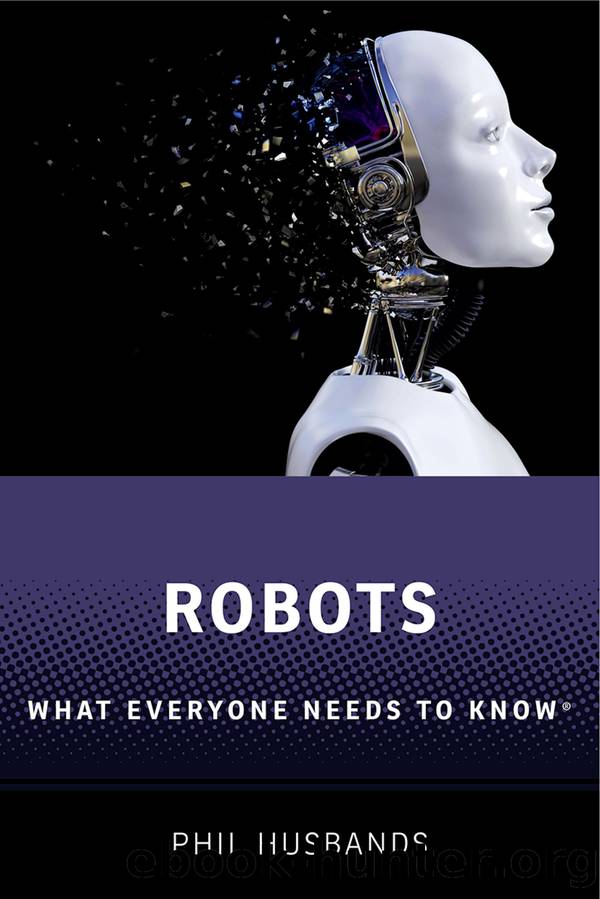Robots by Husbands Phil;

Author:Husbands, Phil;
Language: eng
Format: epub
Publisher: Oxford University Press USA - OSO
Published: 2021-04-15T00:00:00+00:00
How plausible are mainstream fictional portrayals of robots?
Robot portrayals in books and films are mainly fantastical in relation to where real robotic technology is today. But that is to be expectedâthese are works of entertainment after all, often set in some unspecified point in the future. Fictional robots are usually much more intelligent and capable than anything we could build with current technology. Indeed, they are usually far over the horizons of present research.
Where films or books are set at some specified time in the near future, the predicted state of robotics is nearly always highly implausible. Do Androids Dream of Electric Sheep? was set in 1992 when first published, then 2021 in later editions; Blade Runner was set in 2019. Over-optimistic predictions about technological progress were commonplace in the 1950s and 1960s, but even so, the development of intelligent bio-engineered humanoid robots within 30 years of the book being written was a bit of a stretch. Aldous Huxley was wise to set Brave New World 600 years in the future, making the scientific progress needed for his vision more plausible. Likewise, Arthur C. Clarke, one of the most influential of all science-fiction writers, and a trained scientist who cared about the plausibility of his fictional technology, played it safe at the start of his career. In the 1940s he set his stories, which often featured intelligent robots, billions of years in the future. On that timescale any speculation might be reasonable.9 By the 1960s he was merely projecting forward to the twenty-first century (most famously in the screenplay for Stanley Kubrickâs masterpiece, 2001: A Space Odyssey). In the latter case he vastly overestimated the advances that would be made in AI over the 40 or 50 years from when he was writing. This was perhaps understandable, given how young the field was at that time, and how enthusiastically confident were many of its leading lights.
However, one near-future/alternative-present science-fiction TV show, Charlie Brookerâs brilliant Black Mirror, has a very good example of disturbingly plausible future robot technology. The taut, minimalist plot of one episode, Metalhead, involves the protagonist (Bella) being relentlessly chased by a killer robot dog. There is no back-story, but we appear to be in a post-apocalyptic world where robot guard dogsâperhaps military in origin, perhaps from some powerful corporation that once ruledâare now operating outside human control, apparently just inexorably following their programming to hunt down and destroy intruders. Obviously, similar plot elements have been used before in different contexts (the Terminator film franchise comes to mind), but what makes Metalhead almost unique is the way current-day robotics is clearly directly used as the inspiration for the fictional machines, which were in fact created using computer-generated imagery (CGI) in post-production. The look and feel of the robots and the way they move are heavily based on that of advanced dog-like robots built by Boston Dynamics.10 When we see the world through the robotâs eyes it is via (real) LIDAR images. The main behavior of the robots, to
Download
This site does not store any files on its server. We only index and link to content provided by other sites. Please contact the content providers to delete copyright contents if any and email us, we'll remove relevant links or contents immediately.
Machine Learning at Scale with H2O by Gregory Keys | David Whiting(3654)
Fairy Tale by Stephen King(2963)
Zero at the Bone by Jane Seville(2938)
The Man Who Died Twice by Richard Osman(2818)
Oathbringer (The Stormlight Archive, Book 3) by Brandon Sanderson(2657)
Will by Will Smith(2589)
The Stranger in the Lifeboat by Mitch Albom(1943)
Principles for Dealing With the Changing World Order: Why Nations Succeed and Fail by Ray Dalio(1903)
The Complete Witcher by Andrzej Sapkowski(1700)
Cytonic by Brandon Sanderson(1687)
A Short History of War by Jeremy Black(1677)
Go Tell the Bees That I Am Gone by Diana Gabaldon(1601)
Strange Weather in Tokyo by Hiromi Kawakami(1539)
Leviathan Falls (The Expanse Book 9) by James S. A. Corey(1530)
515945210 by Unknown(1524)
Flight by Elephant(1421)
443319537 by Unknown(1400)
A Game of Thrones (The Illustrated Edition) by George R. R. Martin(1376)
The Last Graduate by Naomi Novik(1372)
